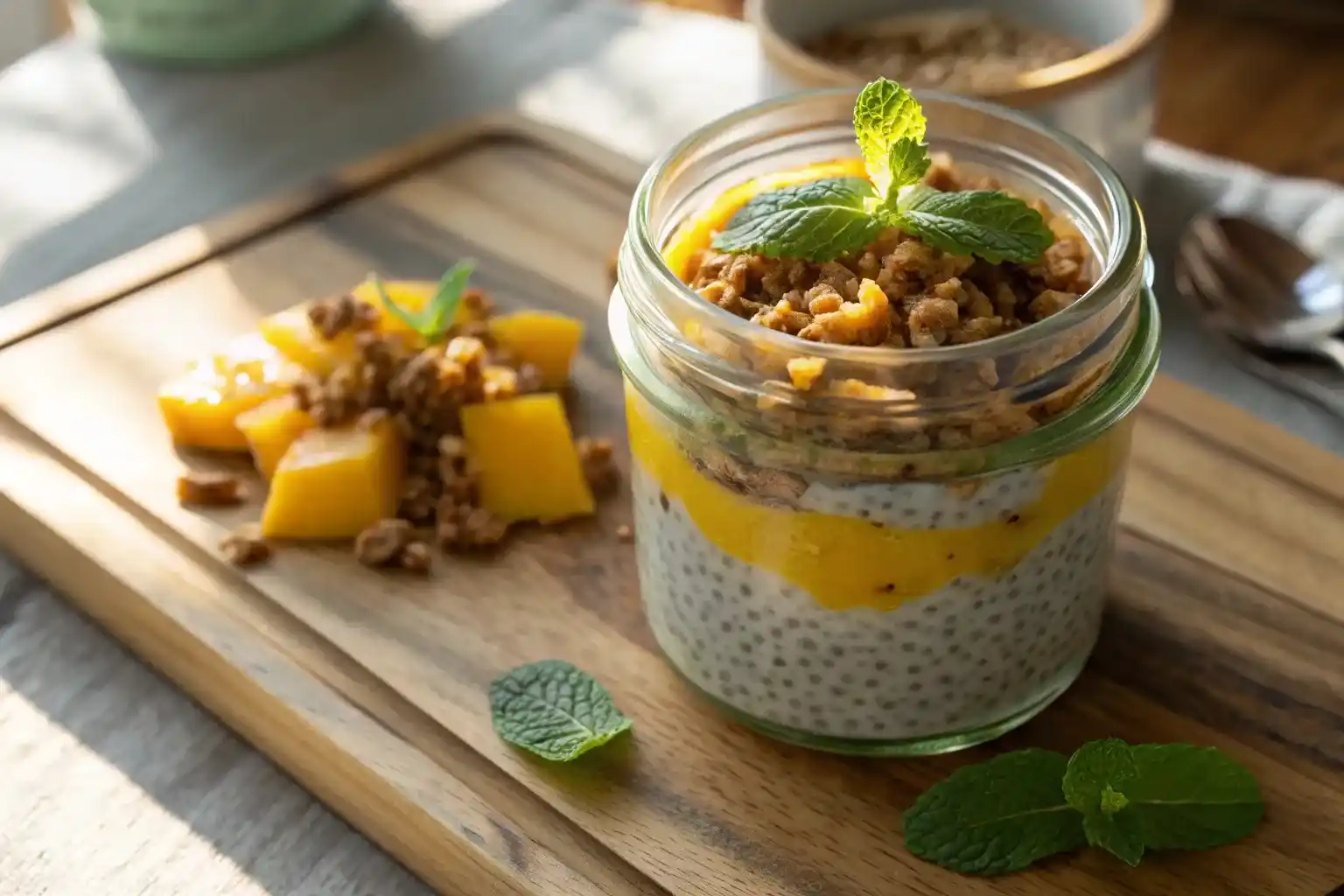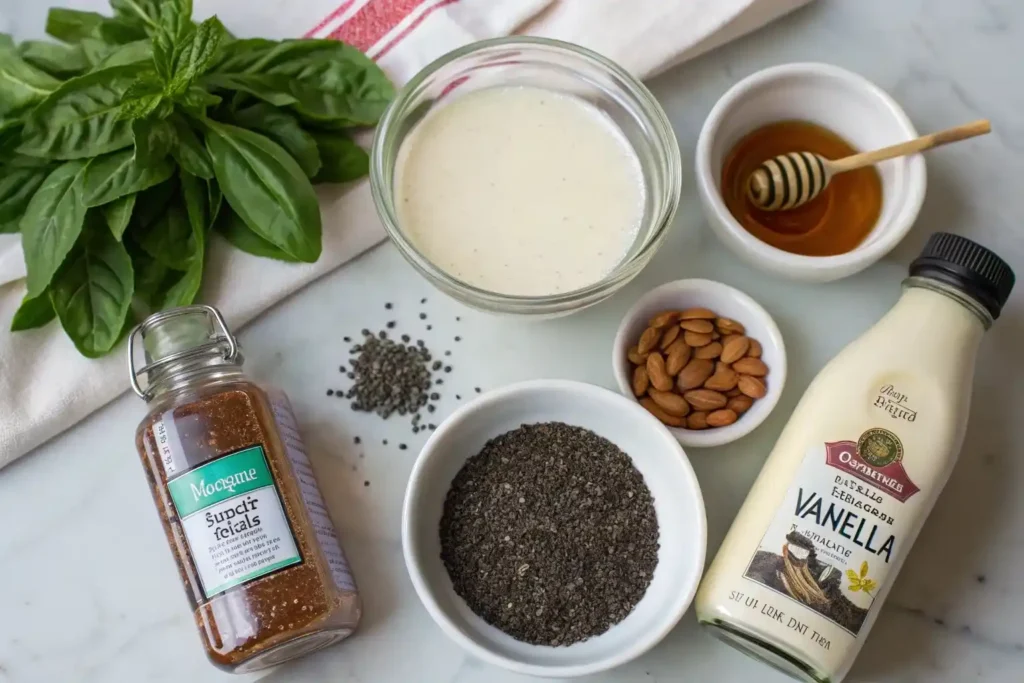Basil seed pudding is more than just a trendy Instagram-worthy treat—it’s a nutritional powerhouse that’s easy to make, delicious to eat, and incredibly beneficial for your body. Packed with fiber, antioxidants, and essential nutrients, basil seeds (also known as sabja seeds) transform into a satisfying, jelly-like dessert when soaked. Whether you’re trying to cool down in summer, improve digestion, or explore vegan sweets, this pudding has something for everyone. In this article, we’ll walk you through everything from how to make basil seed pudding at home to understanding its health benefits, comparing it with chia seeds, and answering the most common questions people ask.
Looking for inspiration? Try our watermelon limeade—another perfect cooling treat to pair with your basil seed dessert!
PART 1: What is Basil Seed Pudding?
What Are Basil Seeds? Nutritional Facts and Benefits
Basil seeds, also called sabja or tukmaria seeds, are derived from the sweet basil plant (Ocimum basilicum), commonly used in Thai and Indian cuisine. While they may resemble chia seeds at first glance, they differ in their nutrient composition and hydration behavior.
Once soaked in water, basil seeds swell rapidly and form a translucent gel coating around each seed, offering a unique texture that makes them perfect for puddings and drinks.
Key nutritional highlights per tablespoon of basil seeds (approx. 13g):
| Nutrient | Amount |
|---|---|
| Dietary Fiber | 7g |
| Protein | 2g |
| Omega-3 Fatty Acids | Moderate |
| Calcium | 15% DV |
| Magnesium | 10% DV |
| Antioxidants | High |
These tiny seeds offer a variety of health perks including blood sugar regulation, improved digestion, and skin hydration.
Check out our ultimate tomato salad recipe for another nutritious and refreshing dish to complement your pudding.
Basil Seed Pudding Explained: Texture, Flavor, and Popular Variations
Basil seed pudding is typically made by soaking the seeds in water or plant-based milk until they become gelatinous. You can then sweeten the base and customize the dish with fruits, nuts, or spices.
Here’s what makes it so special:
- Texture: Slightly crunchy in the center with a jelly-like exterior
- Flavor Base: Mild, often flavored with vanilla, cardamom, rosewater, or coconut
- Popular Pairings: Mango puree, almond milk, dates, coconut flakes, and berries
This pudding is naturally gluten-free, vegan, and low-carb, making it ideal for nearly any diet.
If you’re into quick desserts, don’t miss our 2-ingredient chocolate pudding—a rich and fast treat like this one!
PART 2: Health Benefits of Basil Seeds
How Basil Seeds Support Digestion, Hydration, and Immunity
Basil seeds are a hidden gem in the world of functional foods. When soaked in water, they form a natural gel that makes them perfect for promoting smooth digestion and hydration—especially in hot weather or after a meal.
Here’s a breakdown of how they benefit your body:
- Improved Digestion: The high fiber content in basil seeds helps regulate bowel movements and eases constipation. The gelatinous outer layer adds bulk to stool, making elimination smoother.
- Natural Coolant: In Ayurvedic and traditional medicine, sabja seeds are praised for their ability to reduce internal body heat, especially when consumed during summer.
- Anti-inflammatory Properties: These seeds are rich in antioxidants like flavonoids, polyphenols, and essential oils which fight free radicals and inflammation.
- Hydration Boost: Basil seeds can absorb up to 30 times their weight in water, helping your body stay hydrated longer.
- Immunity Support: Thanks to their antioxidant profile, these tiny seeds help neutralize oxidative stress, boosting your body’s defense mechanisms.
Don’t miss our creamy corn pasta with coconut milk—it’s another dish that supports digestion and comfort.
Why Basil Seeds Are Great for Weight Loss and Detox
If you’re looking for a natural way to cut cravings and feel full, basil seeds are a great ally. Here’s how they can support your weight management goals:
- Natural Appetite Suppressant: When soaked and consumed, basil seeds expand in your stomach and create a feeling of fullness. This can reduce unnecessary snacking or overeating.
- Low-Calorie, High-Nutrient: A tablespoon of basil seeds contains under 60 calories but packs essential nutrients that aid in energy production and metabolism.
- Blood Sugar Regulation: These seeds may help slow down the conversion of carbohydrates to glucose, which is particularly helpful for diabetics or those watching their sugar intake.
- Detoxifying Agent: Their high fiber content helps flush out toxins and cleanse your gut—making them an excellent choice for anyone on a detox or clean-eating plan.
Feeling like snacking on something light? Discover great ideas like these 4-ingredient cookies that can complement your clean-eating plan.
Print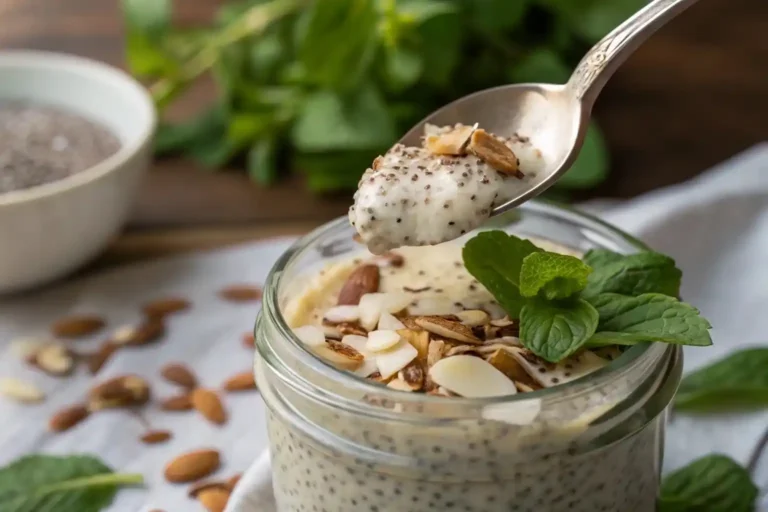
Basil Seed Pudding
A refreshing, fiber-rich basil seed pudding with plant-based milk—cooling, vegan, and perfect for weight-loss desserts.
- Total Time: 1 hour 10 minutes
- Yield: 2 servings 1x
Ingredients
- 2 tablespoons basil seeds (sabja seeds)
- 1 cup unsweetened plant-based milk (almond, coconut, or oat)
- 1–2 teaspoons maple syrup or preferred natural sweetener
- 1/4 teaspoon vanilla extract (optional)
- Fresh fruit, nuts, or coconut flakes for topping
Instructions
- Place basil seeds in a small bowl.
- Add ½ cup warm water, stir, and let soak for 10–15 minutes until gelatinous.
- In another bowl, whisk the plant-based milk, sweetener, and vanilla.
- Stir the soaked basil seeds into the milk mixture until well combined.
- Pour into serving jars, cover, and refrigerate for at least 1 hour or overnight.
- Top with fresh fruit, nuts, or coconut flakes just before serving.
Notes
Adjust sweetness to taste. Always hydrate basil seeds in water first to avoid clumping and ensure smooth texture.
- Prep Time: 10 minutes
- Cook Time: 0 minutes
- Category: Dessert
- Method: No-Bake
- Cuisine: Global
- Diet: Vegan
Nutrition
- Serving Size: 1/2 recipe
- Calories: 150
- Sugar: 6g
- Sodium: 120mg
- Fat: 6g
- Saturated Fat: 1g
- Unsaturated Fat: 5g
- Trans Fat: 0g
- Carbohydrates: 20g
- Fiber: 8g
- Protein: 4g
- Cholesterol: 0mg
Keywords: basil seed pudding, sabja, vegan dessert, weight loss, superfood dessert
PART 3: How to Make Basil Seed Pudding at Home
Ingredients You’ll Need (Basic and Optional Add-ins)
Making basil seed pudding at home is refreshingly simple and takes less than 10 minutes of prep. The ingredients are minimal, customizable, and perfect for healthy snacking.
Basic Ingredients:
- 2 tablespoons basil seeds (sabja seeds)
- 1 cup plant-based milk (almond, coconut, oat, or dairy)
- 1–2 teaspoons natural sweetener (maple syrup, honey, stevia, or dates)
- 1/4 teaspoon vanilla extract (optional)
Optional Add-Ins & Toppings:
| Add-Ins | Benefits & Flavor Notes |
|---|---|
| Chia seeds | Extra fiber and omega-3s |
| Coconut flakes | Texture and tropical flavor |
| Sliced fruits | Vitamins, color, and sweetness |
| Rosewater or cardamom | Traditional Indian flavor twist |
| Crushed nuts | Crunch, protein, and satiety |
Want something indulgent yet healthy? Learn more about the easiest 2-ingredient chocolate pudding—great inspiration for flavor pairings.
Step-by-Step Recipe: Soaking, Mixing, and Chilling
To ensure your basil seed pudding has the right consistency and flavor, follow these simple steps:
Step 1: Soak the Basil Seeds
- Place basil seeds in a small bowl.
- Add ½ cup of warm water and stir well.
- Let it sit for 10–15 minutes until the seeds expand and develop a jelly coating.
- Stir again to avoid clumping.
Step 2: Combine with Milk & Flavorings
- In a separate bowl, mix your preferred milk, sweetener, and any spices or extracts (like vanilla).
- Add the soaked basil seeds and stir until fully combined.
Step 3: Chill the Pudding
- Transfer the mixture to a glass jar or dessert cup.
- Cover and refrigerate for at least 1 hour (or overnight for a thicker texture).
Step 4: Add Toppings & Serve
- Before serving, top with fruits, coconut, or nuts.
- Serve cold for the best flavor and cooling effect.
Pro Tip: Prep this pudding the night before, and you’ll have a ready-to-go healthy breakfast or post-dinner dessert.
This refreshing treat pairs well with cooling drinks. Check out our watermelon limeade to complete your summer menu.
PART 4: Best Basil Seed Pudding Variations
Fruit-Infused Basil Seed Pudding: Mango, Strawberry, Blueberry
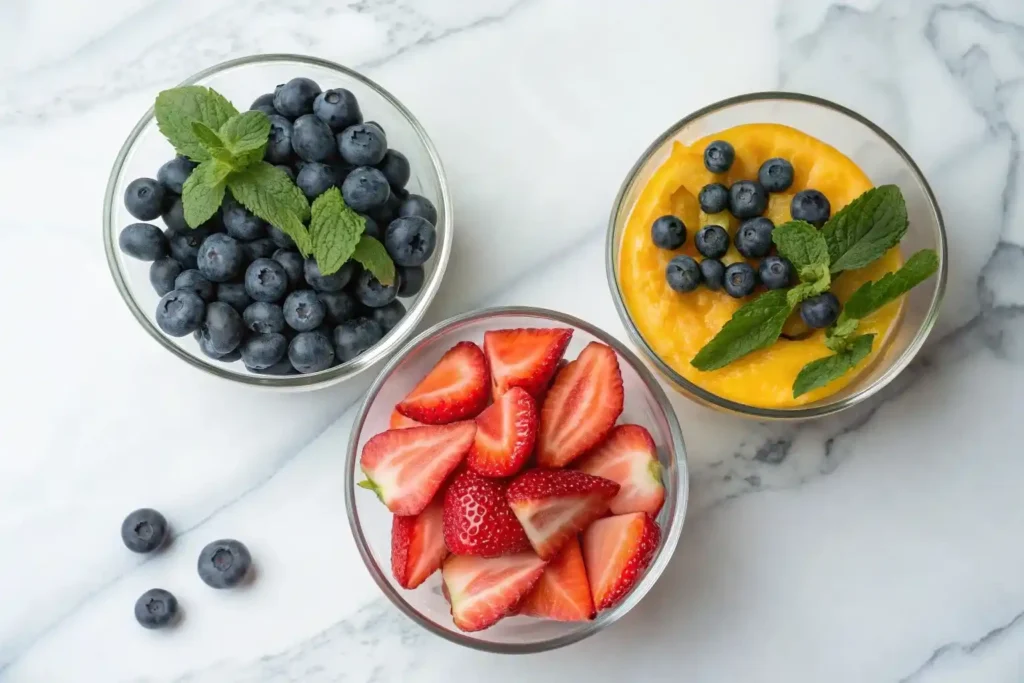
Basil seed pudding is like a blank canvas—it absorbs flavors beautifully, especially fresh fruit. Here are some fruity combinations that elevate this simple dessert into something exciting, vibrant, and nutrient-packed:
1. Mango Basil Seed Pudding
- Blend fresh mango with coconut milk and a splash of honey.
- Mix in soaked basil seeds.
- Top with diced mango and shredded coconut for a tropical finish.
2. Strawberry Vanilla Basil Pudding
- Use vanilla almond milk and a touch of maple syrup.
- Add chopped fresh strawberries or a strawberry puree layer.
- Garnish with mint and chia seeds for added flair.
3. Blueberry Lemon Zest Pudding
- Mix soaked basil seeds with oat milk and lemon zest.
- Stir in fresh blueberries or a blueberry compote.
- Add slivered almonds for crunch and protein.
These fruit combos aren’t just tasty—they’re rich in antioxidants, vitamins, and hydration-friendly. And they’re incredibly Instagram-worthy too!
If you’re a fan of light, refreshing desserts, don’t miss our 4-ingredient cookies—another quick and healthy option.
Vegan, Keto, and Dairy-Free Options
Whether you’re following a plant-based diet or watching your sugar intake, basil seed pudding easily adapts to your needs.
Vegan Basil Seed Pudding
- Use almond, soy, or oat milk.
- Sweeten with agave syrup or dates.
- Flavor with vanilla, cardamom, or rosewater for depth.
Keto-Friendly Version
- Use unsweetened coconut milk or almond milk.
- Opt for erythritol or monk fruit sweetener.
- Add crushed nuts or unsweetened cocoa for richness.
Dairy-Free and Allergen-Free
- Basil seeds are naturally gluten-free and dairy-free.
- Pair with rice milk or flax milk if you have nut allergies.
- Avoid toppings with dairy or gluten to keep it clean.
This dessert is already allergen-conscious, making it a favorite among wellness communities. Want something equally smooth and indulgent? Check out our 2-ingredient chocolate pudding.
PART 5: Basil Seeds vs. Chia Seeds: Which Is Better?
Nutrient Breakdown Comparison Table: Basil Seeds vs. Chia Seeds
Both basil seeds and chia seeds have earned superfood status, but they’re not interchangeable. Here’s a side-by-side comparison to help you understand their key differences:
| Nutrient / Feature | Basil Seeds (per tbsp) | Chia Seeds (per tbsp) |
|---|---|---|
| Calories | ~60 | ~70 |
| Fiber | 7g | 5g |
| Protein | 2g | 3g |
| Omega-3 Fatty Acids | Moderate | High |
| Calcium | High | High |
| Iron | Moderate | High |
| Texture After Soaking | Jelly-like, smooth | Gel-like, with crunch |
| Soaking Time | ~15 minutes | ~2–4 hours |
| Cooling Effect | Strong | Mild |
| Taste Profile | Neutral | Slightly nutty |
As shown, both seeds have impressive nutrition, but they serve slightly different needs.
- Basil seeds are more hydrating and quicker to prepare, with a smoother texture.
- Chia seeds are better for omega-3 content and provide a subtle crunch when soaked.
Don’t miss our refreshing watermelon limeade to pair with either chia or basil pudding—it’s hydrating and naturally sweet.
Which One Works Better for Weight Loss and Gut Health?
When it comes to weight loss and gut health, both seeds shine—but in different ways.
Why Basil Seeds Help with Weight Loss:
- Expand faster and more fully in liquid, increasing satiety
- Rich in soluble fiber, which supports slower digestion and reduced appetite
- Lower in calories than chia, making portion control easier
Why Chia Seeds Are Gut-Friendly:
- Contain insoluble and soluble fiber combo
- Help with bowel regularity
- Deliver anti-inflammatory omega-3s which benefit digestion
Verdict:
If you’re looking for quick prep, hydration, and cooling benefits, basil seeds are your best bet—especially in warm climates or post-meal desserts. For longer satiety and anti-inflammatory perks, chia seeds win.
Tip: For a balanced approach, rotate both into your weekly meals.
If you’re experimenting with gut-friendly meals, check out our creamy corn pasta—it’s soothing, fiber-rich, and easy to digest.
PART 6: Common Questions About Basil Seed Pudding
Can I Make Pudding with Basil Seeds?
Absolutely. In fact, basil seeds are ideal for pudding recipes because of how they expand and turn gelatinous when soaked. This natural thickening ability eliminates the need for cornstarch, gelatin, or processed binders.
All you need is a liquid base (like almond milk or coconut milk), a sweetener, and optional flavorings. Soak the seeds for 10–15 minutes, mix them in, chill, and serve. You’ll get a creamy, nutritious pudding with zero fuss and lots of customization options.
How to Make Basil Seed Pudding?
Here’s a quick breakdown:
Soak 2 tablespoons of basil seeds in ½ cup of water for about 15 minutes.
Stir into 1 cup of your choice of milk, add sweeteners like honey or maple syrup, and optional flavorings like vanilla or cardamom.
Refrigerate for at least 1 hour, then top with fruits, nuts, or granola.
Need more details? Scroll back to Part 3: How to Make Basil Seed Pudding at Home for a full breakdown.
What Are the Pros and Cons of Eating Basil Seeds?
Pros:
Rich in fiber, aiding digestion and weight control
Helps regulate blood sugar
Cooling effect for the body
Anti-inflammatory and antioxidant-rich
Naturally gluten-free and vegan
Cons:
Must be soaked before consuming to avoid choking risk
May cause bloating if eaten in large amounts
Not recommended for people with low blood pressure unless supervised
Can cause discomfort if combined with too little water
Like any superfood, basil seeds are best enjoyed in moderation and as part of a balanced diet.
Which is Better for Weight Loss, Chia or Basil Seeds?
Basil seeds swell faster and larger, which may lead to quicker satiety. They’re also lower in calories per serving. This makes them a great low-calorie filler for weight-loss puddings and snacks.
Chia seeds, on the other hand, provide higher amounts of omega-3 fatty acids and protein, which also support weight management but offer longer-lasting energy.
In the end, both work well—just in different ways. For a light dessert that helps control cravings, basil seed pudding is an excellent choice.
Do Basil Seeds Reduce Body Heat?
Yes, they do. Basil seeds have long been used in Ayurveda and traditional medicine for their natural cooling effect. When soaked and consumed, they help lower internal body temperature, making them perfect for hot climates or post-workout recovery.
Add basil seed pudding to your summer menu or break a sweat with spicy meals—this cooling dessert brings the balance back.
PART 7: Best Times and Ways to Eat Basil Seed Pudding
Morning vs. Night: When to Consume for Maximum Benefits
Basil seed pudding is incredibly versatile, and when you eat it can impact the type of benefits you experience. Here’s how it performs throughout the day:
Morning: Boost Your Metabolism
- A fiber-rich serving in the morning helps curb appetite and prevent overeating later in the day.
- Add protein-rich toppings like almonds, chia, or peanut butter to make it a balanced breakfast.
- Pair with a cup of herbal tea or black coffee for an energizing start.
Bonus: It digests easily, making it a gut-friendly morning meal.
Evening or Post-Dinner: Soothe Digestion & Cool the Body
- The cooling nature of basil seeds helps reduce internal heat and acidity.
- Eating it after dinner may help settle your stomach and promote restful sleep.
- Use cardamom or rosewater for flavor—they’re known to aid in digestion and relaxation.
Want more post-dinner ideas? Check out our 2-ingredient chocolate pudding—simple, soothing, and satisfying.
As Breakfast, Dessert, or Snack? Meal Planning Tips
No matter when you enjoy it, basil seed pudding can be tailored to your meal plan. Here’s how to incorporate it based on your goals:
| Goal | When to Eat | How to Prepare |
|---|---|---|
| Weight loss | Morning or mid-day snack | Use almond milk + berries + stevia |
| Hydration & cooling | Afternoon or post-exercise | Coconut milk + rosewater + soaked seeds |
| Gut health | After dinner | Cardamom-spiced version with fruit compote |
| Protein boost | Post-workout or breakfast | Add Greek yogurt or vegan protein powder |
Whether you need a quick energizer or a light dessert, this pudding fits. Want to balance it with a savory lunch? Don’t miss our creamy corn pasta with coconut milk—rich, satisfying, and digestion-friendly.
PART 8: Troubleshooting & Storage Tips
Why Your Pudding Is Too Runny or Too Thick
Even though basil seed pudding is simple to make, it can occasionally go wrong. Here’s how to fix the most common texture issues:
If your pudding is too runny:
- Problem: Not enough basil seeds or too much liquid.
- Fix: Add 1–2 teaspoons more soaked seeds and chill for another 30 minutes.
- Pro Tip: Basil seeds expand rapidly but need proper ratios. Use 1 tbsp seeds per ½ cup liquid for ideal consistency.
If your pudding is too thick or clumpy:
- Problem: Seeds may have clumped during soaking or absorbed too much liquid too fast.
- Fix: Stir immediately after soaking and again after 5 minutes. Add a splash of milk to loosen it up.
- Avoid: Soaking seeds directly in milk—always hydrate them in water first to prevent clumping.
Don’t miss our creamy 2-ingredient pudding recipe if you want to master textures across different puddings.
How Long Can Basil Seed Pudding Stay Fresh?
Proper storage is key to maintaining freshness, texture, and flavor. Here’s everything you need to know:
Refrigerator (Preferred Method):
- Shelf life: 3–4 days
- Container: Use an airtight glass jar or BPA-free container
- Tips: Keep toppings separate to avoid sogginess. Add fruits or nuts right before serving.
Freezing (Not Recommended):
- Why avoid it? The gel coating of basil seeds may break down and become slimy after thawing.
- Alternative: If you must prep ahead, freeze just the flavored milk base and add soaked seeds after thawing.
For quick prep, store pre-soaked seeds separately in the fridge for up to 5 days, and mix fresh pudding daily as needed.
Looking for a no-bake dessert that holds well in the fridge? Discover great ideas like our 4-ingredient cookies—easy to batch-prep and pair with pudding.
PART 9: Expert Tips for Enhancing Flavor & Texture
Sweeteners, Spices, and Toppings: Vanilla, Cardamom, Coconut
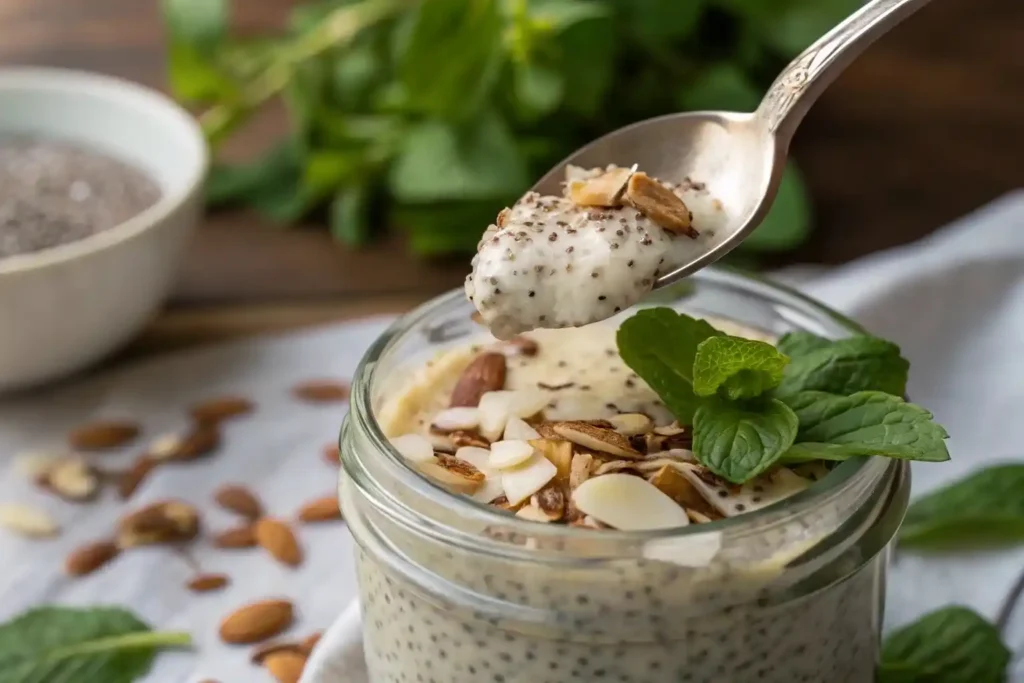
While basil seeds on their own are flavorless, they absorb the taste of whatever they’re paired with. This makes them incredibly versatile—but also means you have to flavor them thoughtfully.
Here are top ways to boost your pudding’s appeal:
Natural Sweeteners:
- Maple syrup: Warm, earthy sweetness—great for fall flavors
- Honey: Classic pairing for nuts and yogurt
- Date paste: Whole-food sweetener with added fiber
- Stevia or monk fruit: Best for keto or low-calorie needs
Flavor Boosters:
- Vanilla extract: Enhances all milk-based puddings
- Cardamom powder: Adds a warm, Indian dessert note
- Rosewater: Perfect for floral, Middle Eastern-inspired flavors
- Lemon zest: Great in citrus or berry-based versions
Best Toppings for Crunch & Contrast:
| Topping | Texture & Flavor Profile |
|---|---|
| Chopped almonds | Crunch, protein |
| Shredded coconut | Tropical vibe, soft chew |
| Granola | Texture, fiber, flavor variety |
| Fresh fruits | Juicy, naturally sweet |
| Pomegranate seeds | Tart pops and vibrant color |
Expert tip: Always add toppings just before serving to avoid sogginess.
Want a beautiful brunch pairing? Don’t miss our creamy corn pasta with coconut milk for a comforting and elegant match to a chilled basil pudding.
Presentation Hacks: How to Layer, Garnish, and Serve
Don’t underestimate the power of visual appeal—especially if you’re sharing your pudding on social media or prepping for a party.
Glass Jars or Layered Cups:
- Alternate layers of pudding, fruit puree, and granola
- Top with a sprinkle of seeds or drizzle of honey
Serve Cold with a Spoon Garnish:
- Add a mint sprig, cinnamon stick, or edible flower
- Serve with a mini spoon and dessert plate for elegance
Meal Prep for the Week:
- Prep 3–4 jars in advance, keeping toppings separate
- Rotate flavors: mango on Monday, berry on Tuesday, cardamom-rose on Wednesday
Looking to impress with your healthy dessert spread? Check out our 4-ingredient cookies to serve alongside for variety and texture contrast.
Conclusion
Basil seed pudding is more than just a healthy dessert—it’s a smart, flavorful way to nourish your body. With its high fiber content, cooling properties, and quick preparation, it’s ideal for everyone from busy professionals to wellness-focused eaters. Whether you’re trying to manage weight, improve digestion, or just want a delicious plant-based treat, this pudding delivers.
Plus, with countless variations—from fruity bowls to spiced night-time snacks—you’ll never get bored. Add it to your weekly meal plan or wow your guests with beautiful jars layered with fruits and nuts. You’re just one soak away from a creamy, satisfying, and superfood-powered dessert.
Don’t miss our other refreshing dessert ideas like 2-ingredient chocolate pudding or light, energizing watermelon limeade for hot days!

